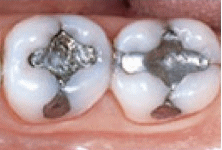| Dental Restorations |

What is Dental Restoration?
Dental restoration is the application of a dental restorative material to replace damaged tooth structures due to tooth decay. The human body does not have a mechanism to heal teeth damaged by tooth decay like it has for many other tissues in the body. The damaged tooth tissues can only be replaced by a dentist with dental restorations using artificial materials.
When you need dental restoration
Tooth decay, also known as dental cavities or dental caries, is the result of the action of acids produced by dental plaque bacteria, which destroy the hard structures of the tooth (enamel and dentin). If the decayed tooth is not treated early enough, the damage may become so extensive that the tooth will have to be extracted. The ability to eat, chew and speak properly may be seriously affected.
The purpose of a dental restoration is to replace the destroyed part of the tooth or teeth with a substitute restorative material or structure in order to restore the teeth’s integrity, shape and functionality. The development of various dental restoration techniques made possible to save many teeth that would otherwise need to be extracted.
Types of dental restorations
Depending on the type of problem, a dental restoration can be used to repair damage to an individual tooth or to replace a small or larger group of teeth. Fillings, inlays, and crowns are intended to repair damage to an individual tooth. They replace the lost tooth structure, protect the remaining part of the tooth, and restore the tooth's aesthetics and function. Bridges and implants are used to replace one or more missing teeth. Complete or partial dentures are intended to restore the functionality of the mouth as a whole.
Dental restorations can be divided into two types: direct restorations and indirect restorations.
- Direct dental restorations are placed in the dental office directly in the patient's mouth (in situ). They include dental amalgam, glass ionomers, resin ionomers and most composite (resin) fillings. The procedure can be completed in a single dental visit.
- Indirect dental restorations are made in a dental laboratory using impressions of the patient’s teeth prepared by the dentist. These usually require multiple (at least two) visits to the dental office. At least one visit is needed to prepare the tooth and take impressions which will be send to the dental lab. A temporary restoration is usually placed on the prepared tooth to protect it. Another visit is required for the application of the final restoration. Common indirect restorations include inlays and onlays, crowns, bridges, veneers and dentures.
Restorations can be made from a number of different materials including amalgam, composite resin, ionomers, metal alloys, porcelain, and porcelain fused to metal. The appropriate type of dental restoration is determined by the dentist after a dental examination depending on the extend of the tooth’s structural damage and the characteristics of each case. The type of material to be used can also depend on the patient’s aesthetic requirements or/and financial constraints.
The following are the most commonly used types of dental restorations:
Dental Fillings
Dental fillings are the most frequently used type of dental restoration for repairing dental cavities. They can be used for restoring decayed areas of small or moderate size in primary or permanent teeth. Dental fillings are direct restorations applied directly on the tooth in the dental office in a single dental visit. There are two basic types of filings:
- amalgam fillings (silver fillings) mostly used to fill cavities on the biting surfaces of the back teeth that have to withstand the most pressure of chewing and grinding, and
- tooth colored fillings (made of composite resin, or glass or resin ionomers) typically used to fill cavities in visible front teeth because they can match to the color of the natural tooth surface.
Inlays and Onlays
Inlays and onlays are indirect dental restorations used to replace decayed enamel on the chewing surface of molars or premolars. The main difference from dental fillings is that they are prepared in the lab and then placed in the mouth. They are usually used for restorations that are too extensive for a filling but not so much to require a crown.
Dental Crowns
A dental crown is an indirect dental restoration that replaces the entire visible part of a tooth (crown). Crowns are used to restore teeth severely damaged by tooth decay when filling or inlays cannot be used. They are also applied on bridges and implants used to replace missing teeth. Crowns are prepared in the dental lab from a mold of the tooth, using gold, metal alloys, porcelain or composite resin alone, or a combination of porcelain fused to metal.
Dental Bridges
Dental bridges are used to fill gaps in the mouth when one or more permanent teeth are lost or extracted. They are fixed restorations of one or more artificial teeth (pontics) anchored by crowns on the adjacent teeth (abutment teeth).
Dentures
Dentures are removable dental appliances consisting of artificial teeth made of porcelain or acrylic resin mounted in a plastic gum-like base. They can be used to replace all missing teeth (full dentures) or several missing teeth in a row (partial dentures).
Dental Implants
Dental implants are small screw-shaped devices made of titanium metal alloy that play the role of artificial tooth roots used for the replacement of missing natural teeth. They are surgically placed in the jawbone to replace the root part of the missing tooth and provide a solid base to support a dental restoration (crown, bridge or denture) that will replace the missing tooth’s crown.
- Dental Plaque
- Dental Calculus
- Gum Disease
- Tooth Decay
- Tooth Abscess
- Toothache
- Tooth Loss
Related Problems
- Root Canal Therapy
- Dental Restoration
- Dental Fillings
- Inlays -Onlays
- Dental Crowns
- Dental Bridges
- Dentures
- Dental Implants
articles about
Tooth Restoration
